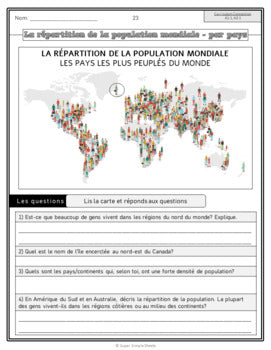Ontario - Grade 8 - Social Studies - Geography - FULL YEAR BUNDLE - FRENCH
Ontario - Grade 8 - Social Studies - Geography - FULL YEAR BUNDLE - FRENCH
Interested in a bundle? Shop below instead!
Couldn't load pickup availability
NEW IN 2022! GOOGLE AND PDF VERSIONS BOTH INCLUDED!
PREVIEW WHAT IS INCLUDED HERE:
EN FRANÇAIS! PERFECT FOR FRENCH IMMERSION! Grade 8 – Ontario Geography Curriculum. This product was created to cover the expectations in the Ontario Geography Curriculum – Global Settlement: Patterns and Sustainability (Les Constantes et développement durable de l'établissement humain dans le monde) & Global Inequalities: Economic Development and Quality of Life (Les inégalités mondiales - la développenent économique et la qualité de vie)
There are 293 activity sheets that cover the expectations in the social studies - geography curriculum. This massive unit contains readings, maps, research assignments and a variety of fun activities - word searches, multiple choice, true/false, and more!
Most importantly, we have made cross-curriculum connections to the grade 8 language program. Students will practice reading comprehension strategies (making connections, summarizing, visualizing, inferencing, and questioning) as they work through this unit.
Check out the preview of this unit to learn more about how it can benefit your students in geography and language!
Strand A: Global Settlement: Patterns and Sustainability
(Les Constantes et développement durable de l'établissement humain dans le monde)
Some of the concepts that are covered:
- Settlement patterns – linear, scattered, and clustered
- Analyzing settlement patterns using pictures
- Research assignment – settlement patterns
- Population density – in Canada and globally around the world
- Calculating population densities
- Reading and creating choropleth maps representing population density
- Population distributions in Canada and globally
- Effects of climate on settlement patterns
- Climate zones – characteristics of zones
- Landforms/Physical features – how they affect settlement patterns
- Resource towns – gold rush, mining towns, forestry communities
- Ghost towns – Dawson City – gold rush
- Land claim disputes between indigenous groups and the government (Crown)
- Coastal GasLink Pipeline – Dispute between the Wet’suwet’en people and the Crown
- Far North Act – Dispute between Indigenous groups and the Crown
- Land use terms – residential, commercial, industrial, transportation, conservation, agriculture
- Land use issues – desertification, deforestation, land degradation
- Urban vs rural living – global trend of moving to urban areas
- Urban sprawl and how it affects the environment
- Pollution caused by settlements – air, land, noise, light, and water pollution
- Waste management – incinerating waste and landfills
- The 7 r’s – reduce, reuse, recycle, refuse, repair, regift, rot
- Land reclamation projects in Kobe, Japan
- Land reclamation projects in Canada – Alberta coal mine and Syncrude Reclamation
- Sustainable development solutions – green cities
- Rainwater harvesting – profile in Brazil
- Greywater systems – Reusing water
- Unit Test
- Answer pages for all activities
Strand B – Global Inequalities: Economic Development and Quality of Life
(Les inégalités mondiales - la développenent économique et la qualité de vie)
Some of the concepts that are covered:
- Quality of life readings
- Researching quality of life indicators
- Infant mortality rates
- Introduction to scatter plots
- Reading scatter plots using different quality of life indicators (ex. infant mortality rate vs poverty rate)
- Creating scatter plots – GDP vs Unemployment and Literacy Rate vs Life Expectancy
- Human Development Index (HDI) rankings
- Comparing Norway (#1) vs Niger (ranked last) in quality of life indicators
- Comparing population pyramids – developed vs developing countries
- Creating population pyramids
- Developed vs developing countries
- Map activity – developed vs developing countries
- Research activity – comparing countries in terms of quality of life indicators
- Study of demography
- NGOs helping inequality issues around the world
- Child rights around the world – UNICEF and Global March Organization
- The Red Cross Organization
- Water for People Organization
- Research – Doctors Without Borders
- Evaluating the Media – How organizations use the media to spread their message
- Economic sectors – primary, secondary, tertiary, and quaternary
- Researching economic sectors in developed and developing countries
- Economic systems – traditional, command, market, mixed-market
- Researching economic systems in different countries and their development (HDI)
- Economic system – North Korea profile (command economy)
- Capitalism – Unequal distribution of wealth
- Wealth inequality – poverty
- Rural poverty vs urban wealth
- Trade balance – trade deficits and trade surplus of countries and comparing to their GDP per capita
- China - economy profile – from command economy towards a mixed market economy
- Corruption index rankings – levels of corruption in different governments/economies
- Unit Test
- Answer pages for all activities
*** Answer sheets have been included ***
Share













